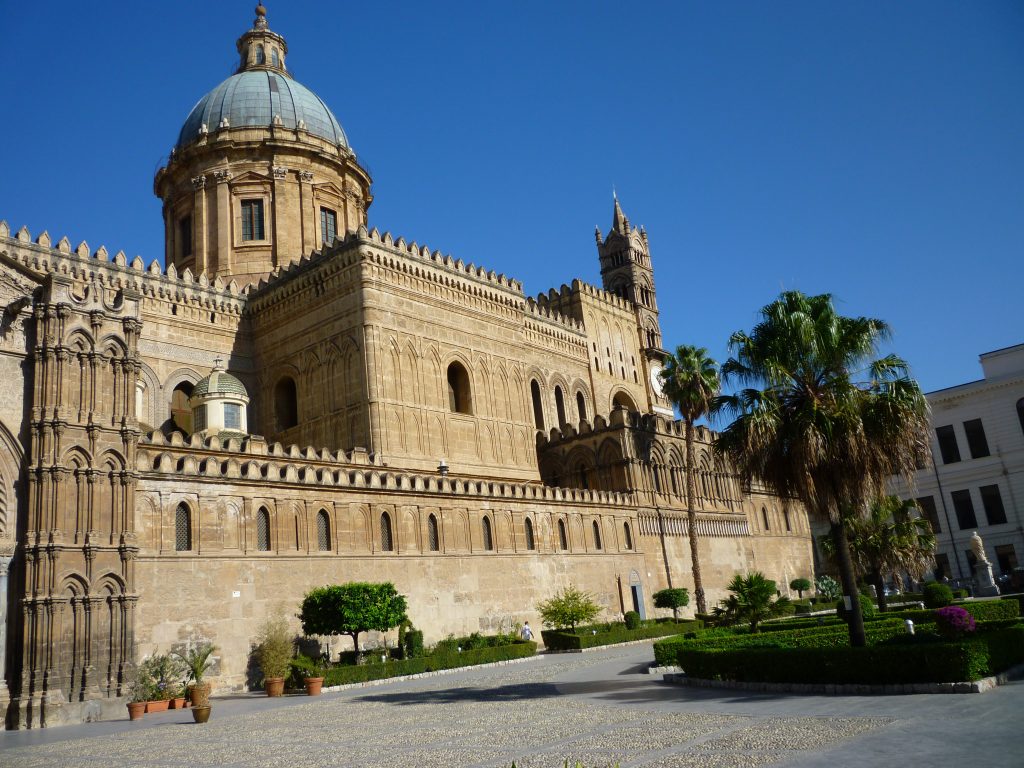The cathedral, which at first glance looks more like a fortified Arabian palace than a Christian place of worship, is set back from Corso Vittorio Emanuele facing a piazza that was once a cemetery. Built in yellow stone with a narrow tower at each corner, it is covered in intricate decoration that continues around the facade to the east side. The west side is joined to the Archbishop’s Palace by two Gothic arches. The arcaded porch which surrounds the main entrance was added in the fifteenth century. Palm trees in the piazza, together with statues of the saints, with Santa Rosalia at the centre, complete the exotic picture.

The fact that the cathedral was founded by an Englishman, Walter of the Mill, known in Sicily as Gualtiero Offamilio, makes it all the more remarkable. Walter came to Palermo as tutor to the royal children and rose up through the ranks to become archbishop and first minister to King William II. He built himself such a powerful position, with the support of leading barons and churchmen, that the king advised by Walter’s arch-rival Matthew of Ajello, decided to create a second archbishopric and cathedral at Monreale to curb his power. Not to be outdone, Walter rebuilt the existing one in Palermo making use of Arab builders and craftsmen. Walter was archbishop from 1169 until his death in 1190 when he was succeeded by his brother Bartholomew.
The cathedral was completed in 1185, towards the end of King William’s reign, and dedicated to the Assumption of the Virgin Mary. The site had long been used for a place of worship. First there was a Christian church on the site, followed by the Arabs’ grand mosque. When the Normans took Palermo in January 1072, the mosque was restored to a Christian church and handed over to the Greek archbishop, Nicodemus. The first cathedral built here by the Normans was linked to the Norman Palace by a street with porticoes called Via Coperta. An unusual touch is the inscription of a verse from the Qur’an, in Arabic, carved on the far left-hand column of the porch in front of the main entrance. Presumably this column was part of the material from the Arab’s grand mosque, reused when building the porch.

A project by Ferdinando Fuga on the orders of the Bourbon King of Naples, Ferdinand IV, radically altered the cathedral between 1781 and 1801. A Baroque-style dome, out of place in this medieval context, was added in this period. Internally, the basilica design was changed into that of a Latin cross with the addition of new columns. The decoration was redone in neoclassical style resulting in the characterless effect we find today. The interest lies in the individual items on display. Among them from Norman and Hohenstaufen times are the tombs of Roger II, who was crowned King of Sicily in the cathedral in 1130, and of his daughter Constance and her husband, the German Emperor, Henry VI. There is also the tomb of Frederick II, stupor mundi, Holy Roman Emperor and King of Sicily (the son of Henry and Constance) and Frederick’s first wife, Constance of Aragon. Artefacts discovered in the tombs include Constance of Aragon’s crown made in the royal workshops around 1220. The crypt, which is accessed through the sacristy beyond the treasury, extends for some way below the cathedral. Historic links to the time of the cathedral’s foundation include sarcophagi, some with elaborate carvings, commemorating the early archbishops. One of them bears the name of Walter of the Mill.
Important from the Baroque era is the chapel of Santa Rosalia, situated to the right of the main altar. Here can be seen the silver urn from 1631 containing the saint’s relics and the ornate silver statue of the saint, standing upon a large silver casket. In the nave are statues of the saints by Antonello Gagini, as well as two decorative stoups, vessels containing holy water, one attributed to Gagini. In the chapel to the right of the main entrance can be seen an altarpiece by Pietro Novelli. Much of the sculpture which was removed from the cathedral by Fuga, including some of Antonello Gagini’s finest work, is on display in the Diocesan Musuem in the Archbishop’s Palace.
The statue of Santa Rosalia defeating the plague, in front of the cathedral, is by Vicenzo Vitagliano from 1744.
For more details see: Palermo, City of Kings, chapters 14 & 15.




